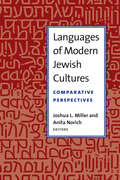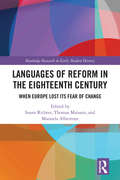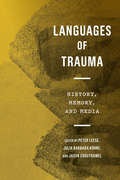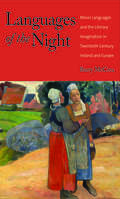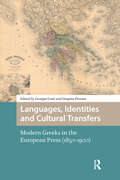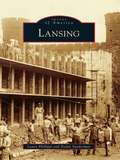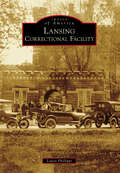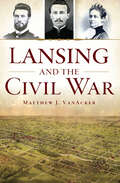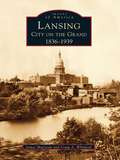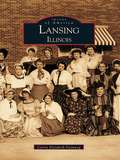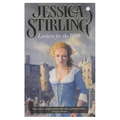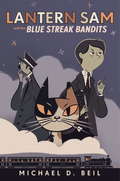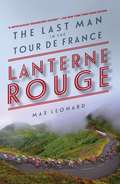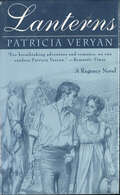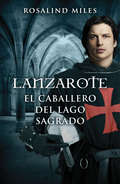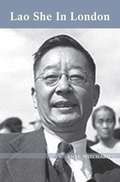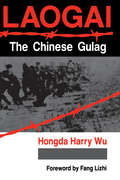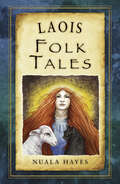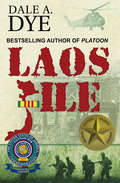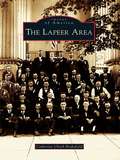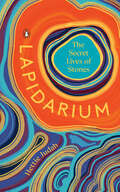- Table View
- List View
Languages of Modern Jewish Cultures: Comparative Perspectives
by Anita Norich Joshua L MillerThis collection of essays brings to Jewish Language Studies the conceptual frameworks that have become increasingly important to Jewish Studies more generally: transnationalism, multiculturalism, globalization, hybrid cultures, multilingualism, and interlingual contexts. Languages of Modern Jewish Cultures collects work from prominent scholars in the field, bringing world literary and linguistic perspectives to generate distinctively new historical, cultural, theoretical, and scientific approaches to this topic of ongoing interest. Chapters of this edited volume consider from multiple angles the cultural politics of myths, fantasies, and anxieties of linguistic multiplicity in the history, cultures, folkways, and politics of global Jewry. Methodological range is as important to this project as linguistic range. Thus, in addition to approaches that highlight influence, borrowings, or acculturation, the volume represents those that highlight syncretism, the material conditions of Jewish life, and comparatist perspectives.
Languages of Reform in the Eighteenth Century: When Europe Lost Its Fear of Change (Routledge Research In Early Modern History Ser.)
by Susan Richter; Thomas Maissen; Manuela AlbertoneSocieties perceive "Reform" or "Reforms" as substantial changes and significant breaks which must be well-justified. The Enlightenment brought forth the idea that the future was uncertain and could be shaped by human beings. This gave the concept of reform a new character and new fields of application. Those who sought support for their plans and actions needed to reflect, develop new arguments, and offer new reasons to address an anonymous public. This book aims to compile these changes under the heuristic term of "languages of reform." It analyzes the structures of communication regarding reforms in the 18th century through a wide variety of topics.
Languages of Trauma: History, Memory, and Media (G - Reference,information And Interdisciplinary Subjects Ser.)
by Peter Leese Jason Crouthamel Julia Barbara KöhneThis volume traces the distinct cultural languages in which individual and collective forms of trauma are expressed in diverse variations, including oral and written narratives, literature, comic strips, photography, theatre, and cinematic images. The central argument is that traumatic memories are frequently beyond the sphere of medical, legal, or state intervention. To address these different, often intertwined modes of language, the contributors provide a variety of disciplinary approaches to foster innovative debates and provoke new insights. Prevailing definitions of trauma can best be understood according to the cultural and historical conditions within which they exist. Languages of Trauma explores what this means in practice by scrutinizing varied historical moments from the First World War onwards and particular cultural contexts from across Europe, the United States, Asia, and Africa – striving to help decolonize the traditional Western-centred history of trauma, dissolving it into multifaceted transnational histories of trauma cultures.
Languages of the Night
by Barry MccreaThis book argues that the sudden decline of old rural vernaculars - such as French patois, Italian dialects, and the Irish language - caused these languages to become the objects of powerful longings and projections that were formative of modernist writing. Seán Ó Ríordáin in Ireland and Pier Paolo Pasolini in Italy reshaped minor languages to use as private idioms of poetry; the revivalist conception of Irish as a lost, perfect language deeply affected the work of James Joyce; the disappearing dialects of northern France seemed to Marcel Proust to offer an escape from time itself. Drawing on a broad range of linguistic and cultural examples to present a major reevaluation of the origins and meaning of European literary modernism, Barry McCrea shows how the vanishing languages of the European countryside influenced metropolitan literary culture in fundamental ways.
Languages, Identities and Cultural Transfers: Modern Greeks in the European Press (1850-1900) (Languages and Culture in History)
by Georgia Gotsi Despina ProvataWhat was the perception of Greece in Europe during the later nineteenth century, when the attraction of romantic philhellenism had waned? This volume focuses on the reception of medieval and modern Greece in the European press, rigorously analysing journals and newspapers published in England, France, Germany, Italy, and The Netherlands. The essays here suggest that reactions to the Greek state's progress and irredentist desires were followed among the European intelligentsia. Concurrently, new scholarship on the historical development of the Greek language and vernacular literature enhanced the image of medieval and modern Greece. This volume's contributors consider the press's role in this Europewide exchange of ideas, explore the links between romantic and late philhellenism and underscore the scholarly nature of the latter. Moreover, they highlight the human aspects of cultural transfers by focusing on networks of mediators, publishers and scholarly collaborators. This context enhances our understanding of both the creation of Hellenic studies and the complex formation of the modern Greek identity.
Lansing (Images of America)
by Nolan Sunderman Laura PhillippiFounded by Civil War veteran William Lansing Taylor, Lansing is home to a population quickly approaching 11,000 residents. It is also home to the Lansing Correctional Facility (formerly the Kansas State Penitentiary), the oldest prison in Kansas. Designed by Erasmus Carr, architect of the Kansas State Capitol, the building has stood watch over the area for more than 140 years. As one will find, Lansing and the prison have grown together and mutually benefitted each other. Lansing is also home to Mount Muncie Cemetery, one of the oldest cemeteries in the state. It is the resting place of several famous people, including Fred Harvey. The photographs in this book are glimpses into time of a small village with one-room schools to a bustling community with one of the busiest north-south highways in Kansas.
Lansing Correctional Facility
by Laura PhillippiSince 1868, the Lansing Correctional Facility (formerly the Kansas State Penitentiary) has stood watch over what would become the city of Lansing. Designed by Erasmus Carr, architect of the Kansas State Capitol, the prison is the oldest in Kansas. In the beginning, it housed male and female inmates from Kansas and Oklahoma, as well as inmates serving federal sentences. Today, the facility's population of minimum, medium, maximum, and special management custody offenders is approximately 2,400. Leavenworth County has also seen the addition of the United States Disciplinary Barracks, United States Penitentiary-Leavenworth, and Corrections Corporation of America-Leavenworth, making it the only county in the country to host a state, military, federal, and private prison. Images of America: Lansing Correctional Facility features photographs of the early days, when inmates were on the "silent system" and could not speak to one another, to more modern times when rehabilitation has become an important component of prison life.
Lansing and the Civil War (Civil War Series)
by Matthew VanAckerWhen war erupted between North and South, the capital of Michigan was ready to serve. The population of Lansing in 1860 was only three thousand, but by the spring of 1865, over five hundred men from the Capital City had enlisted to fight. These citizen-
Lansing, City on the Grand: 1836-1939 (Images of America)
by James Maclean Craig A. WhitfordLansing's history as the capital of Michigan began with a legislative mandate in the 1835 State Constitution, which required that the seat of government be moved from Detroit in 1847. The result-the emergence of a new capital city on the banks of the majestic Grand River-allowed Lansing to cultivate a world-class community based in government, education, the automotive industry, and entrepreneurial achievements. This book features more than 200 historic photographs that document the dynamic capital city during its pivotal first century, from the pioneer era to the inception of the Olds Motor Vehicle Company and through the eve of World War II.
Lansing: Illinois (Images of America)
by Carrie Elizabeth SteinwegLansing, Illinois, is a village that is "proud of its past, confident in its future," according to the signs at its entrance. That proud past began in the 1840s, when Dutch and German settlers first made their way to the area. The town was named for Henry Lansing, who came to the area in 1846 with his brothers, John and George. Through the medium of historic photographs, this book captures the evolution of the people of Lansing, from the late-1800s to the present day. These pages bring to life the people, events, communities, and industries that helped to shape and transform Lansing. With nearly 200 vintage images, Lansing, Illinois, includes photographs of the Indiana Avenue School, the Brickyards, the Ford Airport, and early businesses and business owners. It is hard to imagine Ridge Road, now a bustling center of commerce, as a dirt road scattered with general stores, taverns, and blacksmith shops. This book will take you back to Lansing's simpler days to give the reader a glimpse of why this community has maintained its appeal and held generations of families here in this warm and friendly place.
Lantern For The Dark: Book One
by Jessica StirlingIn Georgian Glasgow, a seventeen-year-old mother stands trial for her life...Clare Kelso has been locked in the Tolbooth, accused of murdering her own infant son. The baby's father has vanished and she has no one to turn to. Maverick lawyer Cameron Adams, summoned from Edinburgh to defend the guilty, soon comes to believe that the frail girl who refuses to defend herself could be a murderer's second victim.The key to the truth lies with Frederick Striker. Gambler, seducer, adventurer, he alone can save Clare from the gallows. If he wishes to . . .Clare and Frederick's tumultuous story continues in Shadows on the Shore.
Lantern For The Dark: Book One (Frederick and Clare #1)
by Jessica StirlingIn Georgian Glasgow, a seventeen-year-old mother stands trial for her life...Clare Kelso has been locked in the Tolbooth, accused of murdering her own infant son. The baby's father has vanished and she has no one to turn to. Maverick lawyer Cameron Adams, summoned from Edinburgh to defend the guilty, soon comes to believe that the frail girl who refuses to defend herself could be a murderer's second victim.The key to the truth lies with Frederick Striker. Gambler, seducer, adventurer, he alone can save Clare from the gallows. If he wishes to . . .Clare and Frederick's tumultuous story continues in Shadows on the Shore.
Lantern Sam and the Blue Streak Bandits
by Michael D. BeilLantern Sam is the wise-cracking, sarcastic, talking cat (for those who can hear him, that is) who lives onboard the Lake Erie Shoreliner train and is one of the best detectives no one knows about. He doesn't have much patience for humans (unless they bring him sardines), but when 10-year-old traveler Henry can't find his new friend, the exuberant Ellie, Sam's enlisted to help. A ransom note is soon discovered and just like that, Sam and Henry are on the case, with the help of Clarence the Conductor (who supplies Sam's sardines). But is Ellie still on board the train? Did the salesman with his trunk full of samples sneak her off? And why does that couple keep acting so suspicious? Veteran middle-grade mystery author Michael D. Beil has crafted a hilarious and appealing adventure set in the 1930s that's chock-full of quirky characters, red herrings, and all with an irresistible cat at its center.
Lantern for the Dark
by Jessica StirlingA Dickensian novel of life in eighteenth-century Scotland chronicles the ordeal of a young mother on trial for murdering her own son. Claire, an orphan with an uncertain future working as a servant for wealthy, distant relatives, is unlucky in trusting a charming but deceitful ne'er do well. Loaded with historic details and complex characters, this suspenseful novel is a combination of historical fiction, romance and legal thriller. It's unsettling ending leaves the reader anxious to dive into the next installment, Shadows on the Shore.
Lanterne Rouge: The Last Man in the Tour de France
by Max LeonardIf you complete a bike race of over 3,000 miles in last place, overcoming mountain ranges and merciless weather, all while enduring physical and psychological agony, should you be branded the loser? What if your loss helped a teammate win? What if others lacked the determination to finish? What if you were trying to come in last? Froome, Wiggins, Mercks--we know the winners of the Tour de France, but Lanterne Rouge tells the forgotten, often inspirational and occasionally absurd stories of the last-placed rider. We learn of stage winners and former yellow jerseys who tasted life at the other end of the bunch; the breakaway leader who stopped for a bottle of wine and then took a wrong turn; the doper whose drug cocktail accidentally slowed him down and the rider who was recognized as the most combative despite finishing at the back. Max Leonard flips the Tour de France on its head and examines what these stories tell us about ourselves, the 99% who don't win the trophy, and forces us to re-examine the meaning of success, failure and the very nature of sport.
Lanterns: A Regency Novel (Sanguinet Saga)
by Patricia Veryan"Reliable Veryan, mixing romance, humor, light mystery, and a satisfyingly noisy finish with just enough touches of period diction and mores to add the right Regency flavor." - Kirkus Reviews"Veryan deftly balances romance, mystery, comedy and - with special poignancy - the conflict Marietta must face, torn between love of country and love of a dashing man." - Publishers WeeklyPatricia Veryan was born in England and moved to the United States following World War II. The author of several critically acclaimed Georgian and Regency series, including the Sanguinet Saga, she now lives in Kirkland, Washington.
Lanzarote, el caballero del lago sagrado (Trilogía de Ginebra #Volumen 2)
by Rosalind MilesLa reina Ginebra y el caballero Lanzarote, una de las historias de amor imposible más conocidas de la literatura. La reina Ginebra se debate entre el deber y el destino, entre su amor por Arturo y su pasión por el caballero Lanzarote, quien también se encuentra dividido entre la lealtad a su rey y el amor a su reina. Finalmente, Ginebra, sacrificando sus sentimientos, decidirá que el caballero del Lago debe marcharse de Camelot. Sin embargo, cuando el reino se vea amenazado por los ataques de Morgana, madre del único heredero de Arturo, y por los caballeros cristianos que quieren acabar con la religión de Camelot, Ginebra reconsiderará su decisión y luchará por su amor a Lanzarote, en quien siempre confió.
Lao People's Democratic Republic: Selected Issues and Statistical Appendix
by International Monetary FundA report from the International Monetary Fund.
Lao She in London
by Anne WitchardLao She remains revered as one of China's great modern writers. His life and work have been the subject of volumes of critique, analysis and study. However, the four years the young aspiring writer spent in London between 1924 and 1929 have largely been overlooked. Dr Anne Witchard, a specialist in the modernist milieu of London between the wars, reveals Lao She's encounter with British high modernism and literature from Dickens to Conrad to Joyce. Lao She arrived from his native Peking to the whirl of London's West End scene - Bloomsburyites, Vorticists, 'avant-gardists' of every stripe, Ezra Pound and the cabaret at the Cave of The Golden Calf. Immersed in the West End 1920s world of risque flappers, the tabloid sensation of England's 'most infamous Chinaman Brilliant Chang' and Anna May Wong's scandalous film 'Piccadilly', simultaneously Lao She spent time in the notorious and much sensationalised East End Chinatown of Limehouse. Out of his experiences came his great novel of London Chinese life and tribulations - 'Mr Ma and Son: Two Chinese in London' ('Er Ma', 1929). However, as Witchard reveals, Lao She's London years affected his writing and ultimately the course of Chinese modernism in far more profound ways.
Laogai: The Chinese Gulag
by Hongda Harry Wu Ted SlingerlandLaogai: The Chinese Gulag by Hongda Harry Wu. Translated by Ted Slingerland.
Laois Folk Tales (Folk Tales)
by Nuala HayesFrom miracle-working saints and shape-shifting witches to silent ghosts and wailing banshees, County Laois is teeming with folk tales and a selection of the best, drawn from historical sources and interviews, have been brought to life here by storyteller by Nuala Hayes. This book will take you on a journey through the county’s varied landscape, from the rugged Slieve Bloom Mountains to its fertile plains, with tales of talking cats, bewitched butter, fairy changelings and holy fish. On the way you will meet characters like the great warrior Conall Cearnach, from whom the people of Laois are said to be descended; Moll Anthony, the wisewoman of the Red Hills; and the White Lady said to haunt Durrow Castle. Richly illustrated by internationally renowned artist Rita Duffy, these enchanting stories can be enjoyed and shared time and again.
Laos File (Shake Davis Series)
by Dale A. DyeMilitary Writers Society of America 2011 Book Award winner: From the bestselling author of Platoon comes a military thriller about one Marine’s quest to leave no POW behind. The death of a salty old senior noncommissioned officer who ran special operations in Vietnam leads US Marine Gunner Shake Davis on a shocking and potentially lethal mission to find out what happened to hundreds of American prisoners of war. With “plenty of action and lots of military detail” (Vietnam Veterans of America), Laos File is a great read for fans of Tom Clancy and W. E. B. Griffin.
Lapeer Area, The
by Catherine Ulrich BrakefieldLegends about the Ottawa, Chippewa, and Nepessing Indians have left an indubitable mark upon the Lapeer area. Streets, rivers, and towns sing out the melody of their ageless legacy, just as those first settlers of Lapeer left their footprints upon the towns and cities for generations to follow. Like a comfortable rocker, the lyrics of hospitality linger, whispering of a way of life not easily left within the pages of a history book. Frugal, yet compassionate, these early pioneers shared their meager provisions and scant shelters with the tribes and wayward travelers alike. Lumberjacks sawed and farmers harvested their crops, threshed their grain, raised their barns, and worshipped together. Feuds never lasted and families never parted. The people of the Lapeer area worked, voted, and played together, creating a place of beauty for the generations they would never know. The gentle rolling hillsides still ring with their music, whether it is the moccasin footsteps of the first hunter, the boot-clad lumberjack or farmer, or the European tradition of riding to the hounds-for here the panoramic view of the Lapeer area comes alive with heritage, horses, and hills.
Lapham's Raiders: Guerrillas in the Philippines, 1942–1945
by Robert Lapham Bernard NorlingA US soldier recounts his extensive guerilla campaign against the Japanese occupation of the Philippines in this thoroughly researched WWII memoir.On December 8th, 1941, the day after the attack on Pearl Harbor, the Japanese invaded the Philippine Islands, catching American forces unprepared and forcing their eventual surrender. Among the American soldiers who managed to avoid capture was twenty-five-year-old Lieutenant Robert Lapham, who played a major role in the resistance to the brutal Japanese occupation.After emerging from the jungles of Bataan, Lapham built and commanded a devastating guerrilla force behind enemy lines. His Luzon Guerrilla Armed Forces evolved into an army of thirteen thousand men that eventually controlled the entire northern half of Luzon's great Central Plain, an area of several thousand square miles. In Lapham’s Raiders, Lapham and historian Bernard Norling reconstruct the drama of the LGAF through letters, records and the recollections of Lapham and others.Lapham’s Raiders sheds light on the clandestine activities of the LGAF and other guerrilla operations, assess the damages of war to the Filipino people, and discuss the United States' postwar treatment of the newly independent Philippine nation. It also examines Japan's wartime failures in the Philippines and elsewhere, and of America's postwar failure to fully realize opportunities there.
Lapidarium: The Secret Lives of Stones
by Hettie JudahInspired by the lapidaries of the ancient world, this book is a beautifully designed collection of true stories about sixty different stones that have influenced our shared historyThe earliest scientists ground and processed minerals in a centuries-long quest for a mythic stone that would prolong human life. Michelangelo climbed mountains in Tuscany searching for the sugar-white marble that would yield his sculptures. Catherine the Great wore the wealth of Russia stitched in gemstones onto the front of her bodices. Through the realms of art, myth, geology, philosophy and power, the story of humanity can be told through the minerals and materials that have allowed us to evolve and create. From the Taiwanese national treasure known as the Meat-Shaped Stone to Malta&’s prehistoric &“fat lady&” temples carved in globigerina limestone to the amethyst crystals still believed to have healing powers, Lapidarium is a jewel box of sixty far-flung stones and the stories that accompany them. Together, they explore how human culture has formed stone, and the roles stone has played in forming human culture.
